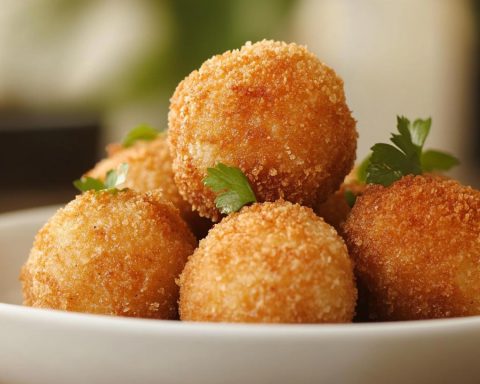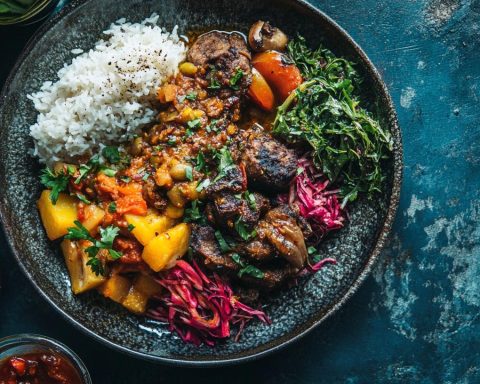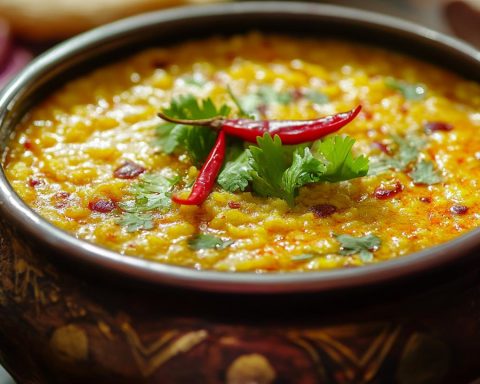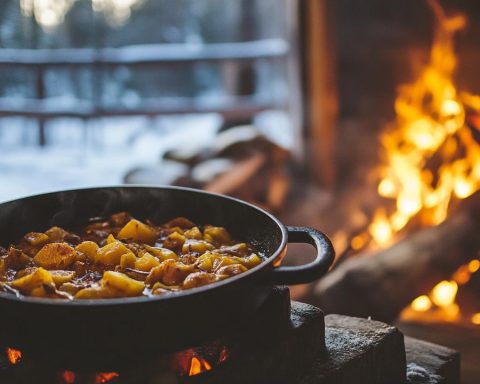Uzbek Plov is more than just rice pilaf; it is a rich tapestry woven from fragrant spices, tender meats, and the soulful art of communal dining. Born in the heart of Central Asia, this dish has been a central figure in celebrations from weddings to family gatherings, offering comfort with every forkful. Imagine the warmth of a shared table as the aroma of cumin and coriander mingles with the sweet undertones of caramelized onions and carrots, all merging into fluffy, perfectly cooked rice. It’s a dish that brings people together, each serving crafted with love and a touch of nostalgia.
Ingredients:
– 500g boneless lamb or beef, cut into 1-inch cubes
– 300g long-grain rice (preferably basmati)
– 3 large carrots, julienned
– 2 large onions, thinly sliced
– 100ml vegetable oil or lard
– 1 garlic bulb
– 1 tbsp cumin seeds
– 2 tsp ground coriander
– 1 tbsp paprika
– Salt and black pepper to taste
– 1.2 liters of water
– Optional: raisins, barberries, or chickpeas for added sweetness and texture
Instructions:
1. Prepare Ingredients:
Begin by washing the rice in cold water until the water runs clear. This step is crucial to remove excess starch and ensure the rice is fluffy. Let it soak in water for about 30 minutes while you prepare the rest of the ingredients.
2. Brown the Meat:
In a large, heavy-bottomed pot or Dutch oven, heat the oil over medium-high heat. Add the meat, browning on all sides. This step not only locks in the juices but also forms a flavor base for the dish. Tip: Ensure the pot is not overcrowded to allow optimal browning.
3. Sauté the Vegetables:
Add the onions to the meat and sauté until golden brown. Then, add the julienned carrots, continuing to cook until they are tender and slightly caramelized. This will take about 10 minutes, infusing the oil with sweet, savory flavors.
4. Spice it Up:
Stir in the cumin seeds, ground coriander, and paprika. Allow the spices to bloom in the hot oil for about 1-2 minutes, releasing their aromas and deepening the flavor of the dish. Season with salt and pepper as needed.
5. Simmer and Stew:
Pour in the water and bring it to a gentle boil. Reduce the heat to low, cover the pot, and let it simmer for about 45 minutes to an hour. This process will tenderize the meat and meld the spices into a rich broth. Tip: If using chickpeas, add them at this stage to avoid over-softening.
6. Prepare the Rice Layer:
Drain the soaked rice and carefully layer it over the simmering mixture. Insert the whole garlic bulb into the rice. This will impart a mellow garlic flavor throughout. Do not stir the rice into the rest of the ingredients; instead, gently push it down with a spoon.
7. Final Simmer:
Increase the heat to medium and let the plov cook uncovered until the majority of the liquid has evaporated. Then, reduce the heat to the lowest setting, cover, and let it steam for another 20 minutes, allowing the rice to absorb the remaining flavors.
8. Serve and Share:
Once the plov is done, remove it from the heat. Gently stir the rice to mix in the meat and vegetables. Serve it family-style on a large platter, ideally in a pyramid shape, and garnish with optional raisins or barberries for a touch of sweetness.
Pairing Suggestions:
Serve Uzbek Plov with freshly baked flatbread and a simple tomato-onion salad dressed with lemon juice for a refreshing contrast. A robust black tea or a glass of pomegranate juice can complement the flavors beautifully.
Delight in the communal joy and rich tradition that this dish embodies, knowing you’re partaking in a culinary experience cherished for centuries.
Unlocking the Secrets of Uzbek Plov: Beyond the Recipe
Uzbek Plov, a dish steeped in tradition, holds more than its hearty ingredients suggest. While the warm, aromatic combination of rice, spices, and meat creates an irresistible culinary experience, there are fascinating nuances and controversies surrounding this iconic dish that might surprise even seasoned chefs and food enthusiasts.
Did You Know? Plov, also known as “pilaf” in other regions, traces its roots back to ancient times, believed to have been first mentioned by historians in the 10th century. However, the precise origin remains a subject of debate among historians: was it born in Persia, or did it evolve from the Middle East into Central Asia?
An intriguing fact is the role Plov plays in Uzbek culture beyond mere sustenance. Traditionally prepared by men, often called “oshpaz,” or master chefs, the cooking process is considered an art form, with specialized techniques passed down through generations. The dish not only nourishes but also showcases one’s culinary prowess and ability to foster community.
Why So Controversial? One point of contention within the Uzbek Plov culture is its perfect execution. The balance of meat-to-rice ratio, choice of spices, and cooking method can vary widely, sparking heated debates. Purists argue over the inclusion of non-traditional elements like barberries or chickpeas, hinting at evolving culinary tastes that incorporate personal twists on the classic recipe.
Have You Tried? Ever considered cooking Plov outdoors? In Uzbekistan, the best plovs are often cooked in a large kazan over an open flame during community events, offering a distinct smoky flavor you can’t achieve on a stovetop.
For more on Uzbek culture and cuisine, explore visit Uzbekistan for a deeper dive into its rich culinary traditions and other historical insights.







